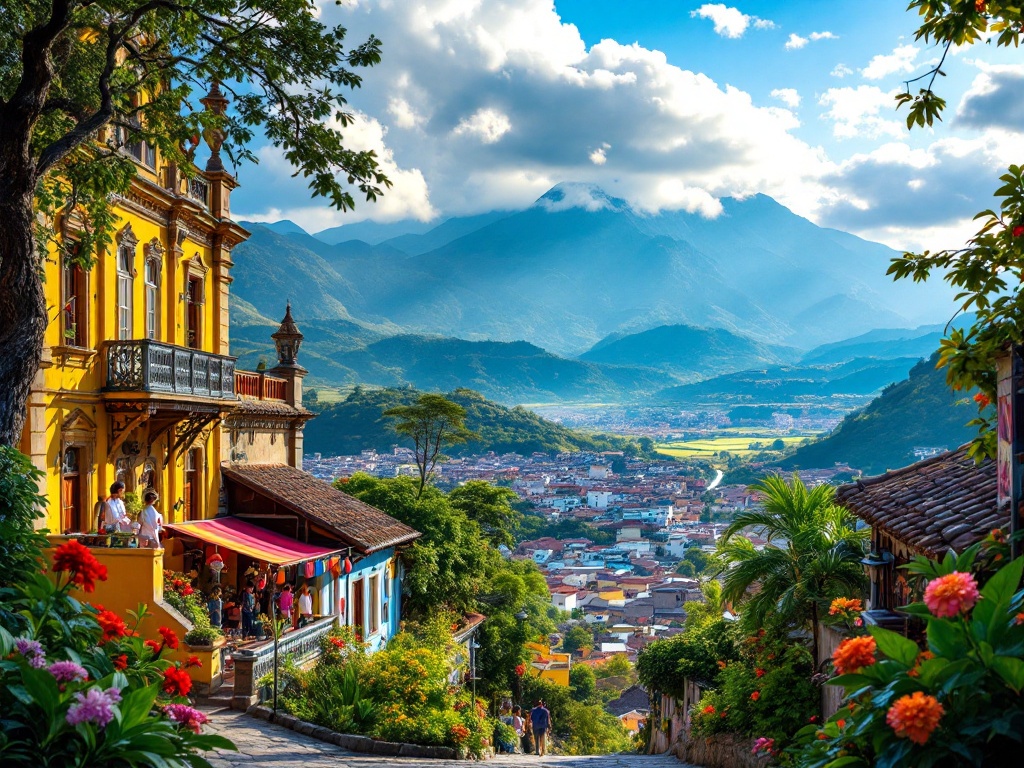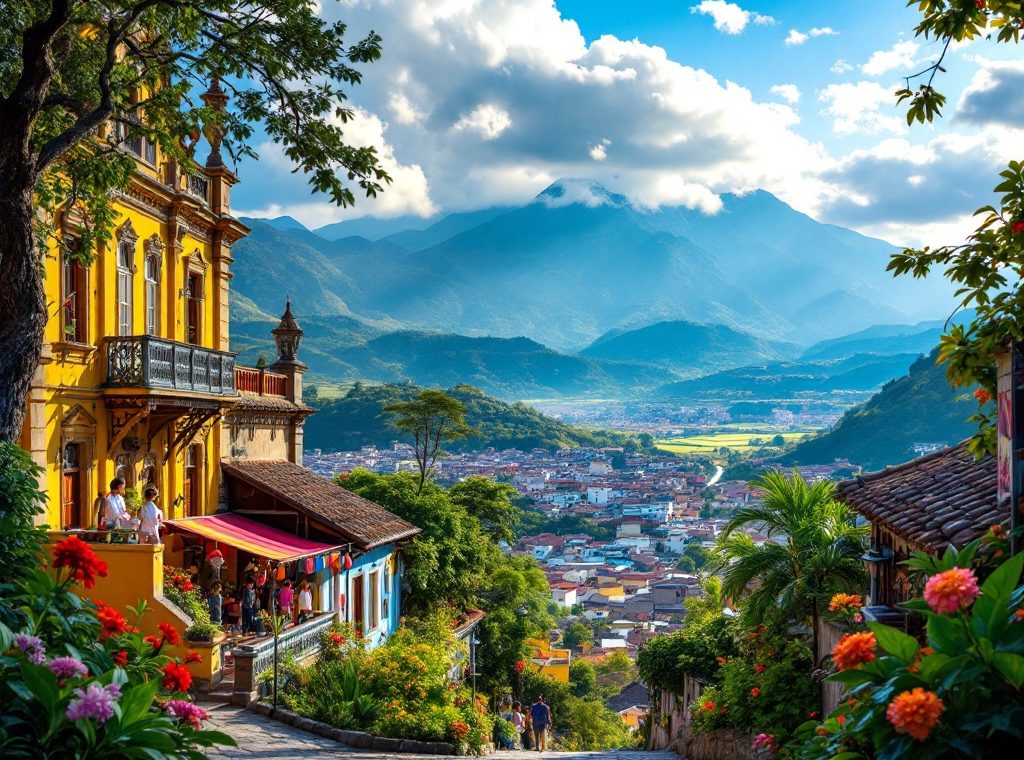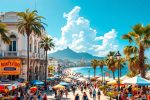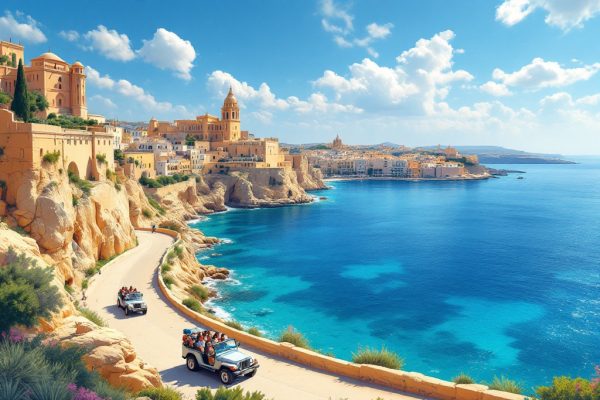Exploring the Cultural Tourist Attractions in Ecuador
Discover the vibrant cultural tapestry of Ecuador! From the colonial charm of Quito and Cuenca, both UNESCO World Heritage sites, to the bustling indigenous markets of Otavalo and the ancient Inca ruins of Ingapirca, an unforgettable journey awaits. Explore the Amazon rainforest, hike the majestic Andes, and even encounter the unique culture of the Galapagos Islands. Uncover the rich traditions, captivating history, and breathtaking landscapes of Ecuador. Start planning your cultural adventure today!
Important information

- Ecuador’s culture blends indigenous, Incan, Spanish, and African influences, visible in its architecture, markets, festivals, and art.
- Quito, the capital, is a UNESCO World Heritage site, showcasing colonial architecture and indigenous traditions.
- Cuenca’s colonial architecture, artisan crafts, and museums highlight its rich history and artistic heritage.
- The Otavalo Market offers an immersive experience of indigenous culture, featuring textiles, crafts, and traditions.
- Ingapirca, the largest Inca ruin in Ecuador, provides insights into pre-Columbian history and Inca architecture.
Introduction to Cultural Tourist Attractions in Ecuador
Ecuador, a South American gem, vibrantly blends indigenous traditions, colonial history, and modern life. Explore this rich tapestry in regions like Quito, Cuenca, Otavalo, and Alausí, each offering a unique glimpse into Ecuadorian culture. From historic cities and bustling indigenous markets to UNESCO World Heritage sites, discover Ecuador’s captivating past. Even the Galapagos Islands offer cultural encounters, emphasizing local communities and their customs.
Quito
Quito’s stunning historic center, a designated UNESCO World Heritage site, captivates with its colonial architecture.
Cuenca
Cuenca boasts beautiful colonial buildings and vibrant artisan markets.
Otavalo Market
Otavalo Market, a shopper’s paradise, is renowned for its indigenous crafts.
Ingapirca
Ingapirca unveils the wonders of the Inca civilization.
Amazon Rainforest
The Amazon rainforest offers a chance to explore indigenous communities.
Understanding Ecuadorian Culture
Ecuador’s vibrant culture is a fascinating blend of indigenous traditions, Incan history, Spanish customs, and African influences. The Amazon’s indigenous cultures are particularly significant, enriching Ecuador’s heritage. The Inca Empire also left an enduring legacy, notably at the Ingapirca archaeological site. Spanish colonization introduced European traditions and Catholicism. African influences are especially evident along the Pacific coast. This fusion creates a unique cultural tapestry, expressed through lively festivals, music, dance, and art.
Influences Shaping Ecuadorian Culture
Ecuadorian culture is a vibrant tapestry woven from Indigenous Amazonian practices, Incan heritage, Andean traditions, and the lasting influence of Spanish colonialism. This rich blend creates a unique national identity evident in the country’s art, celebrations, and everyday life, captivating all who encounter it.
The Role of Festivals in Cultural Heritage
Ecuadorian festivals vibrantly express the nation’s rich cultural heritage, seamlessly blending indigenous beliefs with Catholic traditions. These diverse celebrations reflect various aspects of life, from religious devotion and agricultural cycles to unique indigenous customs. They offer a fascinating glimpse into Ecuador’s history, highlighting strong community bonds and the country’s cultural complexity. Inti Raymi and the Day of the Dead, for instance, captivate with traditional music, vibrant dances, and delicious food.
Exploring Quito: A Cultural Fusion
Quito, Ecuador’s capital, is a captivating fusion of indigenous traditions and Spanish colonial influences, evident in its architecture, art, and culture. The historic center, a UNESCO World Heritage site, perfectly embodies this blend.
Quito’s historical landmarks showcase its rich past. These include the Basilica del Voto Nacional and La Compañía de Jesús, architectural marvels reflecting the city’s history. The Plaza Grande, also known as Independence Square, stands as another vital historical and cultural touchstone.
In 1978, Quito became the first city designated a UNESCO World Heritage Site. This honor recognizes the city’s well-preserved colonial architecture and unique cultural mix within its historic center. It highlights Quito’s significance on the world stage.
Quito’s Architectural and Cultural Significance
Quito’s captivating cityscape seamlessly blends colonial and indigenous architecture. Its historic center, recognized as a UNESCO World Heritage site, exemplifies this remarkable fusion, underscoring the city’s vital role as Ecuador’s cultural hub.
Historical Sights and Monuments in Quito
Quito’s historical treasures include the stunning neo-Gothic Basilica del Voto Nacional, a must-see for any visitor. Equally impressive is La Compañía de Jesús, a Jesuit church renowned for its ornate beauty. The Plaza de la Independencia, surrounded by historic buildings, further emphasizes the city’s rich past. These sites showcase Quito’s unique blend of indigenous and colonial influences.
A UNESCO World Heritage Site, Quito’s historic center beautifully preserves colonial architecture.
To delve into pre-Columbian history, journey to Ingapirca, Ecuador’s largest Inca archaeological site. Here, impressive Inca stonework offers valuable insights into this ancient civilization and Ecuador’s captivating past.
UNESCO World Heritage Sites in Quito
Quito’s Historic Center, a UNESCO World Heritage site, boasts remarkably preserved colonial architecture. Its churches, plazas, and monuments, such as the Basilica del Voto Nacional and La Compañía de Jesús, showcase a blend of Spanish colonial and indigenous traditions, offering a glimpse into the city’s rich and vibrant cultural heritage.
Cuenca: Colonial Charm and Cultural Riches
Cuenca, renowned for its colonial architecture and charming cobblestone streets, boasts a vibrant cultural scene. Its historic center, a UNESCO World Heritage site, features well-preserved colonial buildings blending Spanish and indigenous influences. The city is also known for artisan crafts, especially Panama hats. Numerous museums, art galleries, and theaters further enrich Cuenca’s cultural landscape.
Colonial Architecture
Key examples of Cuenca’s colonial architecture, such as the Old and New Cathedrals, showcase the city’s history and architectural prowess. These structures reflect Spanish colonial styles while incorporating local materials and craftsmanship.
Religious Heritage
Cuenca’s impressive colonial churches include the iconic New Cathedral with its blue domes and the Old Cathedral, now a museum. These sacred spaces reveal the city’s religious history and architectural heritage.
Beyond colonial architecture, Cuenca’s Museum of Modern Art features contemporary Ecuadorian and international works. Museums dedicated to indigenous cultures preserve and celebrate Ecuador’s diverse heritage, offering insights into the country’s rich past.
Architectural and Historical Buildings
Cuenca’s stunning architecture captivates with a blend of Spanish colonial and indigenous influences. As a designated UNESCO World Heritage site, the historic center showcases beautiful churches and charming cobblestone streets. Grand colonial buildings grace the avenues, while local materials, such as red-tiled roofs and wooden balconies, contribute to the city’s unique character. This distinctive architecture reflects Cuenca’s rich history of social and economic development.
Colonial-style Churches in Cuenca
Cuenca’s colonial churches, especially the New and Old Cathedrals, are stunning testaments to Spanish influence. These magnificent structures artfully blend Baroque, Renaissance, and Gothic styles, using local volcanic rock and incorporating indigenous motifs to create a unique cultural fusion. These architectural gems serve not only as places of worship but also as repositories of Cuenca’s rich history and artistic legacy.
Museum of Modern Art and Indigenous Cultures
Cuenca’s Museum of Modern Art showcases a vibrant collection of contemporary Ecuadorian art.
The Museum of Indigenous Cultures explores the region’s pre-colonial past, offering a fascinating glimpse into its history.
Together, these museums reveal Cuenca’s rich and diverse cultural heritage, telling a compelling story of its artistic and historical evolution.
Otavalo: A Hub of Indigenous Culture
Experience the vibrant indigenous culture of Otavalo, Ecuador, centered around its renowned market. This bustling marketplace showcases exquisite textiles, crafts, and traditional clothing, making it a must-see attraction.
Every Saturday, the Otavalo Market transforms into a vibrant spectacle of indigenous people in traditional attire, creating an authentic cultural immersion. Considered one of South America’s largest markets, it plays a crucial role in supporting local artisans economically while preserving their rich cultural heritage.
Visitors can discover unique souvenirs that reflect the region’s history and artistry. The market offers an opportunity to engage with local artisans, learn about indigenous customs, and enjoy traditional music and dance performances, creating a truly immersive cultural experience.
Otavalo’s incredibly skilled artisans create colorful textiles and handcrafted goods that beautifully showcase Ecuador’s indigenous culture. The market also provides a chance to savor traditional foods, adding another layer to the cultural experience.
The Otavalo vendors play a vital role in cultural exchange, highlighting the importance of indigenous heritage in modern Ecuador. The market connects visitors with these artisans, offering a vibrant glimpse into Ecuador’s cultural heart and showcasing the community’s unique cultural expressions.
Vibrant Otavalo Market
The Otavalo Market, renowned for its vibrant textiles and crafts, is a hub of indigenous Ecuadorian culture, drawing both locals and tourists. This bustling marketplace offers a unique peek into Ecuador’s rich traditions, allowing visitors to connect with local artisans and purchase handcrafted goods. It’s a truly immersive cultural experience.
Andean Textiles and Artisan Crafts
Otavalo artisans weave beautiful Andean textiles, a vibrant expression of Ecuador’s cultural heritage. Their artistry is showcased at the bustling Otavalo Market, a hub of indigenous culture. Here, local vendors display their skills, selling intricately woven textiles, ponchos, and other handcrafted treasures.
Cultural Significance of Otavalo Vendors
Otavalo vendors, hailing from neighboring Andean villages, play a crucial role in safeguarding their rich cultural heritage. Their handcrafted goods offer a tangible link to ancient traditions, providing a glimpse into the past. The Otavalo Market serves as a vibrant hub for cultural exchange, where these artisans sustain and ensure the future of Andean traditions.
Alausí and the Nariz del Diablo
Alausí, a charming town nestled in Ecuador’s Andes Mountains within the Chimborazo province, is famous for its thrilling Nariz del Diablo train ride. This unforgettable journey ascends a steep mountain using a series of switchbacks, offering breathtaking views. Alausí also boasts a vibrant Sunday market. This bustling marketplace provides a unique opportunity for genuine cultural exchange and a chance to discover local crafts and produce.
Scenic Train Journey to Alausí
Experience an unforgettable train journey through the breathtaking Ecuadorian Andes to Alausí. Witness dramatic mountain vistas and create lasting memories as you travel through this stunning landscape.
Sunday Market: Connecting with Locals
Experience the heart of Alausí at the vibrant Sunday Market, a central hub for connecting with the community and experiencing local life.
Ingapirca Archaeological Site: Insights into Ecuador’s Past
Ingapirca, Ecuador’s most extensive Inca ruin, showcases a fascinating blend of Inca and Cañari architecture. The site’s remarkable Temple of the Sun, with its elliptical design and meticulously crafted stonework, stands as a testament to Inca astronomical knowledge and sophisticated building techniques. This significant site demonstrates the Inca empire’s vast reach, extending into present-day Ecuador.
Ingapirca illuminates the Inca’s interactions with the indigenous Cañari people.
Archaeological findings there offer glimpses into pre-Columbian life, revealing religious practices and daily routines.
Its strategic location suggests Ingapirca served as an important administrative and ceremonial hub.
The Largest Inca Ruins in Ecuador
Ingapirca, Ecuador’s most extensive Inca ruin, offers a captivating glimpse into Inca architecture and its integration with local cultures. The site reveals fascinating insights into their world.
Pre-Columbian History and Early Inhabitants
Ingapirca offers a glimpse into Ecuador’s captivating pre-Columbian history. Originally inhabited by the Cañari people, renowned for their building and astronomical prowess, the site later fell under Inca rule, becoming part of their sprawling empire. This resulted in a unique blend of Inca and Cañari architectural styles, particularly evident in the Temple of the Sun. This significant structure served as both an astronomical observatory and a place of religious ceremonies. Ingapirca’s strategic location and sophisticated construction demonstrate a profound understanding of the natural world, reflected in the practices of these ancient societies.
Cultural and Natural Wonders Beyond the Cities
Ecuador’s Amazon rainforest teems with indigenous tribes, each upholding unique customs and traditions that offer glimpses into ancient ways of life. Visitors can explore their villages, learn about the medicinal uses of plants, and even participate in traditional ceremonies.
The Andes Mountains, sacred to Ecuadorians, influence their spiritual beliefs and agricultural practices. This region presents fantastic hiking opportunities, chances to engage with local communities, and witness time-honored traditions.
The Galapagos Islands offer a unique journey where nature and culture intertwine. Renowned for their wildlife, the islands also possess a rich human history, allowing visitors to learn about evolution and the impact of human settlement.
Ecuador’s Pacific coast vibrates with the energy of Afro-Ecuadorian culture. Known for vibrant music, dance, and cuisine, the coastal areas offer immersive experiences of these traditions, enhanced by lively local festivals.
Exploring the Amazon Rainforest and Indigenous Tribes
Experience the rich indigenous cultures of Ecuador’s Amazon rainforest. Learn about their unique customs and traditions, medicinal plants, and rituals. Participate in immersive tours, including stays with local families to witness their daily lives firsthand. Explore the deep connection between nature and these vibrant cultures through guided rainforest excursions.
The Andes Mountains and Their Cultural Significance
The Andes Mountains hold deep spiritual significance for Ecuador’s indigenous people, shaping their identity and heritage. Visitors can experience this rich culture through vibrant festivals and by exploring local markets. From vibrant textiles and captivating music to energetic dances, the region is alive with color. The Andes also boasts delicious cuisine. Tourists can participate in hands-on weaving and pottery workshops for a truly unique cultural immersion.
Galapagos Islands: A Natural and Cultural Journey
The Galapagos Islands are a captivating intersection of nature and culture, renowned for their extraordinary wildlife and volcanic landscapes. Dramatic peaks and rugged lava fields paint a scene of natural wonder, while the islands’ historical significance, particularly their influence on Darwin’s theory of evolution, adds a layer of cultural richness. Local communities champion conservation efforts, diligently protecting this precious ecosystem. The Galapagos offer a unique experience showcasing nature’s power and the vital role of human stewardship.
Pacific Beaches and Afro-Ecuadorian Culture
Ecuador’s Pacific coast offers breathtaking beaches and a vibrant Afro-Ecuadorian culture. This rich heritage is expressed through captivating music, dance, and cuisine unique to this coastal region. Communities celebrate their traditions with distinctive rhythms, movements, and flavors, making the culture both fascinating and engaging.











